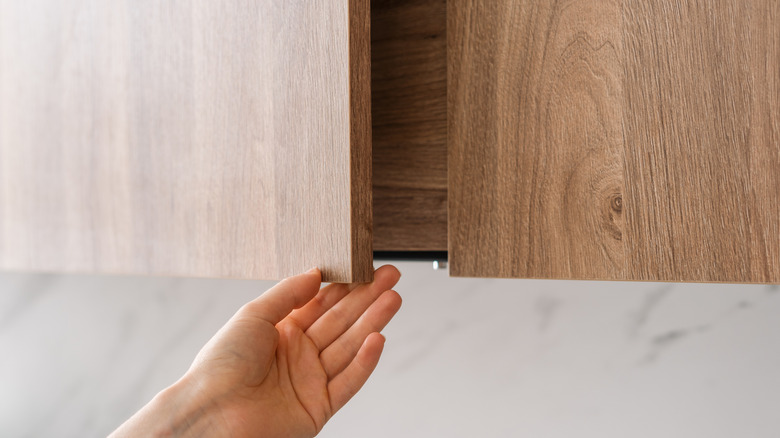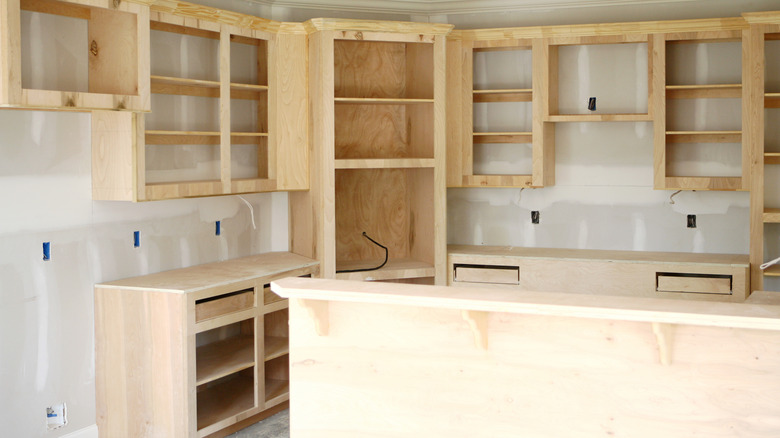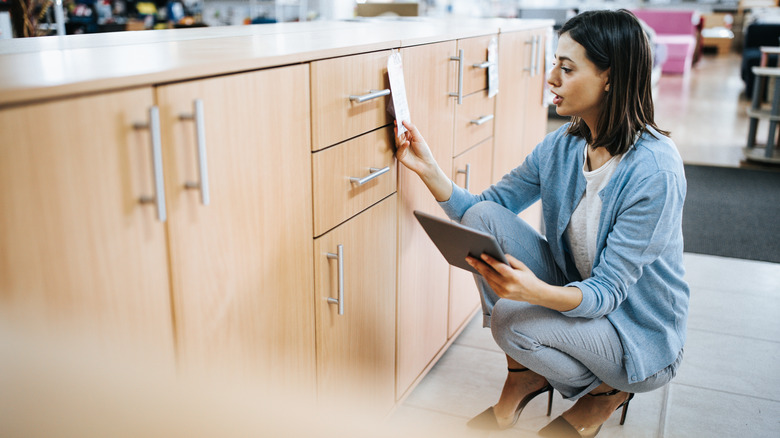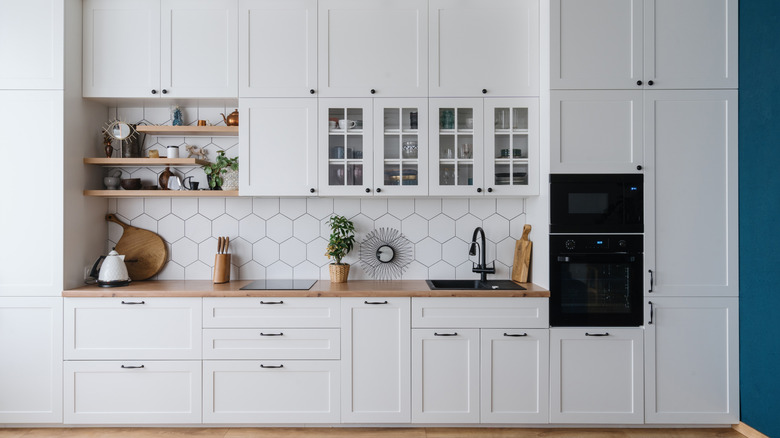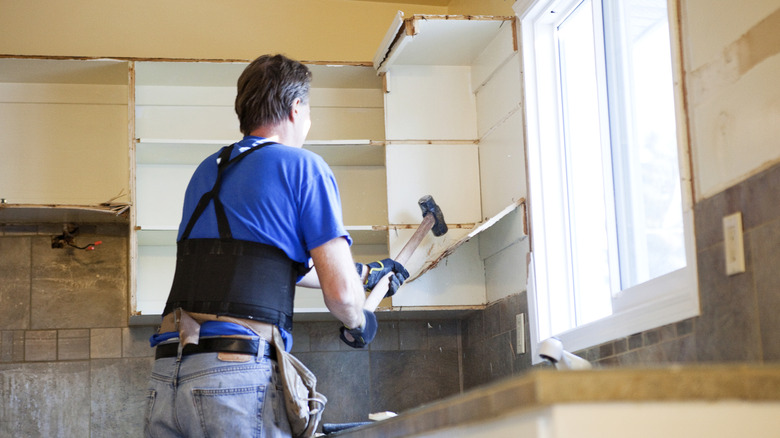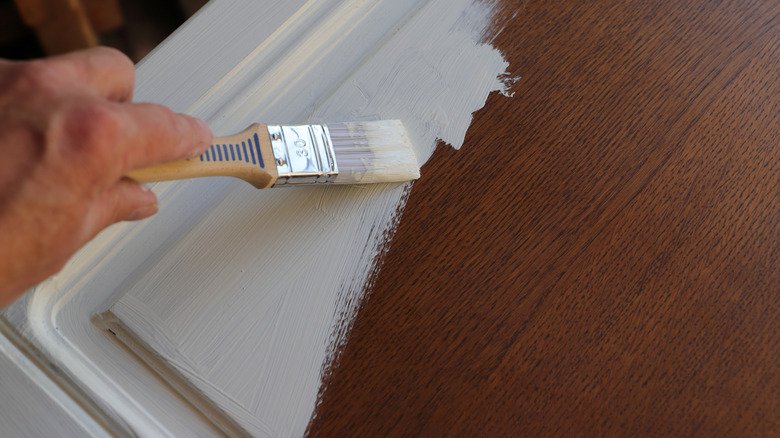Top Tips For Replacing Your Kitchen Cabinets On A Budget
Replacing your kitchen cabinets can totally refresh the look and feel of your space. But it's no secret that a completely new cabinet installation comes with a hefty price tag. In fact, they are usually the most expensive part of a kitchen remodel. The average cost runs from $4,000 to $14,000, depending on materials, finishes, hardware, and craftsmanship. Even what seems like a simple update can quickly become a big expense if you don't plan for it carefully.
But updating your kitchen cabinets doesn't have to break the bank. With some clever choices, like selecting affordable materials, exploring ready-to-assemble (RTA) or semi-custom options, and tackling certain tasks yourself, you can refresh your kitchen without spending as much. Rethinking finishes and making smart use of tools are also ways to save on costs while giving the heart of your home an update. Here are some practical ways to save on replacing your kitchen cabinets while creating a space you'll enjoy for years to come.
Opt for affordable cabinet door styles
One factor that drives up the cost of new cabinets is the doors you choose. If you select a simpler door style, you can solve this problem while still making your project visually appealing and practical. Quality features to look for when purchasing kitchen cabinets include slab or flat-panel doors, which give you a clean, contemporary look that can complement your overall kitchen aesthetics. They're also easier to clean and maintain because there aren't any deep grooves that collect dust or grease.
When choosing the right kitchen cabinet style for your space, start by looking at prefab door options rather than ornate designs. You'll find that most manufacturers offer a wide range of affordable styles. Slab doors are suitable for modern spaces, while shaker-style doors provide a versatile option that pairs well with almost all decor. Keep in mind that pieces will vary depending on the manufacturer, so compare samples before settling on a style.
Use low-cost materials to construct your cabinets
The problem is that material costs can take up most of your overall spend, even before you factor in things like hardware or finishes. New kitchen cabinets can become expensive if you choose premium hardwood. Choosing more affordable materials means you can spend money where it'll have the most impact, like durable hinges, smooth drawer glides, or high-quality paint. It's also a chance to get creative with finishes that make inexpensive materials look custom-made.
For cost-effective construction, pine and oak are more affordable solid wood options. Plywood or MDF can also be great budget-friendly options when they're sealed and finished properly. MDF, in particular, gives you a smooth surface which is ideal for painted kitchen cabinets. Plywood, on the other hand, provides added rigidity for cabinet boxes. Always ensure that the materials you choose are moisture-resistant, especially if you're going to be installing them near sinks or dishwashers. You can also mix your materials, like using plywood for your kitchen cabinet framing and MDF for doors and panels.
Rent tools for a day or two instead of buying them
Replacing kitchen cabinets often means you'll need tools you don't necessarily already have. Buying all this equipment yourself can make your project really expensive, especially if you'll only use the tools once. Renting the tools you need for a day or two gets you access to professional-grade equipment without a costly investment. It also means you're getting tools that are of good quality and well-maintained, which can make your kitchen cabinet installation faster and more precise.
To get the most value, start by making a list of every tool you'll need for your project. Then, contact hardware stores or tool rental centers to compare rates. Many places offer weekend packages or hourly options for shorter jobs. For example, renting a cordless drill for a day might cost around $27, compared to over $179 to buy a new one. When you're renting tools, be sure to ask about deposits and damage policies, and return tools on time to avoid extra charges. Another advantage of this is that, if you're unsure how to use them, many rental centers can offer you some expert advice.
Opt for RTA cabinets to save extra
Hiring a contractor to install new kitchen cabinets will quickly increase the cost of your renovation. Ready-to-assemble kitchen cabinets mean you don't have to pay for installation at all. They arrive flat-packed and often have pre-drilled holes and labeled parts. This makes them easy to assemble if you're a DIYer with basic skills. And don't worry, just because they come out of the box doesn't mean RTA kitchen cabinets aren't stylish. They often have sleek finishes, sturdy hardware, and a professional look and feel.
When you purchase RTA kitchen cabinets, check the specifications before you place your order. Many cabinet suppliers provide online tools that let you visualize layouts and ensure accurate measurements before you buy. For assembly, you'll usually only need basic tools: A drill, a screwdriver, and a level, and kits often come with step-by-step instructions. For an average-sized kitchen, you can expect to spend around $1,000 on RTA cabinets, which cost a lot less than custom cabinetry. Make sure you set aside a full weekend for the build, as precision is essential to a professional-looking job.
Purchase stock cabinets that you can customize
Custom-built kitchen cabinets often give you freedom to choose designs and styles, but this often means long lead times and a significant price tag. Stock cabinets, on the other hand, don't cost as much, and you won't have to wait around for them to be ready. They're pre-manufactured and come in standard sizes and styles, which helps keep costs lower, though you may have fewer options for customization.
You can expect to pay roughly $100 to $300 per linear foot for stock cabinetry, depending on materials and finish. Big-box retailers and online suppliers usually have a wide selection for you to choose from, from classic Shaker fronts to glossy modern panels. To make your stock cabinets look even better, think about upgrading small details such as handles or crown molding. Just keep in mind that you might need to do a bit more maintenance to keep them in good shape as the years go on.
Opt for semi-custom cabinets for savings and style
If a custom cabinet installation is a little more than what you've budgeted, semi-custom cabinets may be the answer, because they're a lot more affordable. They also give you the ability to tailor things like the door style, finish, and hardware. This means you'll still get a high-end look that fits your kitchen layout without a massive dent in your pocket.
To get the most from semi-custom kitchen cabinets, start by deciding which elements matter most for your space. Prices for semi-custom kitchen cabinets range from $100 to $650 per square linear foot, depending on what materials and custom features you select. Make sure you work with a reputable supplier who can guide you on what's adjustable and what isn't, as some aspects, like internal shelving, can't always be customized. Another idea is to pair semi-custom kitchen cabinets with inexpensive extra touches, like RTA upper shelves or stock base units, to maximize your kitchen's style without overspending.
Install professionally-crafted cabinets yourself
If you have the budget for custom kitchen cabinets, you can cut costs by installing them yourself. A benefit of handling this aspect of the project is that you cut out labor costs, as cabinet installers often charge between $50 and $250 per hour. However, you'll need the right tools and some patience to get a professional-looking result. Setting aside enough time and using the right tools means you can still get a polished look.
Not being prepared for the job is a common mistake that many make with a DIY kitchen cabinet installation. Start by getting everything you'll need for the project together, including a cordless drill, block plane, level, framing square, hammer, tape measure, and utility knife. Measure your kitchen and mark the wall studs to securely mount your cabinets. Start with your upper cabinets and make sure they're leveled and aligned before moving onto the base units. Take your time with tasks like shimming and adjusting, as even minor misalignments can affect doors and drawers. Keep in mind that your custom cabinets can be heavy and more complex to install than stock options. So, enlist a friend or family member with DIY skills to help if possible.
Consider adding some trendy open shelving
Kitchen cabinets can sometimes make a space feel heavy or closed-in, especially in a smaller space. When replacing your kitchen cabinets, consider leaving space to create open shelving. It's a gorgeous kitchen cabinet trend that can completely transform your space. This can also help you cut costs by reducing the number of cabinets that you need to purchase. Just keep in mind that open shelves might need more upkeep to keep dishes and surfaces dust-free, so they're best for items you use or clean often.
Start by deciding which sections of your cabinets could function without doors. These will typically be upper cabinets above counters. Make sure your shelves are sturdy enough to hold everyday items by constructing them from high-quality wood or well-supported plywood. Wall anchors and brackets may be necessary if you plan to store dishes or small appliances on these shelves. For a cohesive look, consider painting or finishing them to complement your kitchen cabinets. When you're displaying items in your open shelves, group them neatly and use baskets or containers for smaller objects to maintain a tidy look.
Remove your existing cabinets yourself prior to professional installation
The time and effort it takes to remove your existing cabinets are part of the cost of installing the new ones. So, you may save between $350 and $800 in labor for this task by removing your existing cabinets yourself. While this project may seem daunting, even novice DIYers can get it right and save a good amount.
The process is straightforward: Clear out your kitchen, detach the doors and shelves, and carefully unscrew the cabinets from the wall. For upper units, get someone to help lower them safely. Beyond simply saving money, DIY removal gives you the chance to keep them intact and repurpose or resell them, especially if they're still in good condition. You could list them on online marketplaces to make money to offset the cost of your new ones, rather than just tossing them out. Or install them in your garage, laundry room, or workshop to create extra storage space.
Remodel and customize used kitchen cabinets
Finding used kitchen cabinets means you may get quality work at a lower cost. It also gives you room to customize your cabinets any way you like. Look for options with solid construction and classic styles, which provide a great foundation for a refreshed kitchen. If you select your used cabinets carefully and finish them well, they can look just as beautiful as custom-made units.
Start by searching online marketplaces, yard sales, salvage yards, and even the scratch-and-dent sections of home improvement stores. If you find used kitchen cabinets that you like, inspect their structural integrity for water damage or any signs of warping. Cabinets that are 18 millimeters thick or more are likely more durable and long-lasting. Once you've purchased your used cabinets, you can refinish them or swap hardware to match your kitchen's overall style. Adding trim or crown molding can also elevate the look and feel of your new installation.
Measure carefully to avoid extra costs
Taking the wrong measurements is a common issue in kitchen cabinet projects, and this can end up costing you extra money if you're not careful. Cabinets that don't fit properly can create gaps, require additional cuts, or may even create the need to reorder material. Proper measuring ensures each cabinet fits precisely and reduces the risk of mistakes. Having the correct dimensions also helps to maintain the flow of your kitchen layout so that drawers and doors align perfectly.
To get your measurements of the space right, start by drawing a detailed floor plan of your kitchen. Note every wall, corner, and obstruction like plumbing and electrical outlets. Then measure horizontal and vertical dimensions carefully, double-checking each value before you include it in your floor plan. When measuring your kitchen, use a metal tape measure for accuracy and mark reference points on the walls lightly with a pencil. If your kitchen layout includes irregular walls or non-standard heights, take multiple measurements at different points and plan for minor adjustments.
Keep your current kitchen layout for a less expensive remodel
Changing the layout of your kitchen can quickly turn a simple cabinet replacement into a complicated and expensive renovation. Moving sinks, appliances, or electrical outlets often requires rerouting plumbing, gas lines, and wiring. Even minor adjustments, like shifting a corner cabinet, can create gaps or require custom filler pieces that cost more. Maintaining your existing layout also makes it a lot easier to install your new cabinets.
To keep your kitchen layout as is, plan your cabinet replacement project around your current units. Consider using stock or semi-custom cabinets that mirror your current layout without needing any structural changes. Pay attention to elements like windows and doors to ensure your new units fit seamlessly around them. For a fresh look, focus on cosmetic updates rather than moving walls or utilities. Although using your original kitchen layout may not give you a complete overhaul of the space, it'll still help you achieve a functional kitchen that feels newly renovated.
Finish custom-made kitchen cabinets yourself
Another way to save on replacing your kitchen cabinets is by finishing custom-made units yourself. So, you'd order your customized cabinets, but you wouldn't have the manufacturer complete the project by applying the finish. The costs involved in refinishing kitchen cabinets average about $4 to $10 per square foot. Among the common kitchen cabinet finishes, painting and staining are the most affordable options.
The process involves light standing, priming if you're painting, and applying durable, moisture-resistant finishes designed for kitchens. Finishing your units yourself can save you a significant amount of money on labor while still achieving a professional and appealing result. Plus, you also get full control over the color, texture, and finish quality, which lets you create a truly personalized look. Ensure you add a clear protective topcoat to add extra durability, which can help your cabinets look fresh and polished for years to come.

